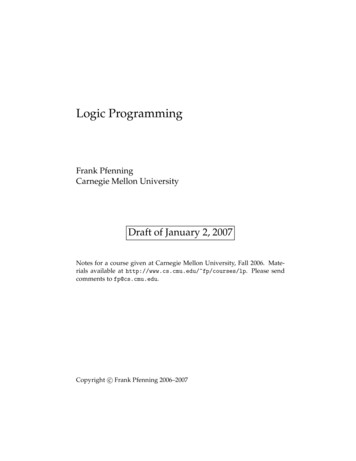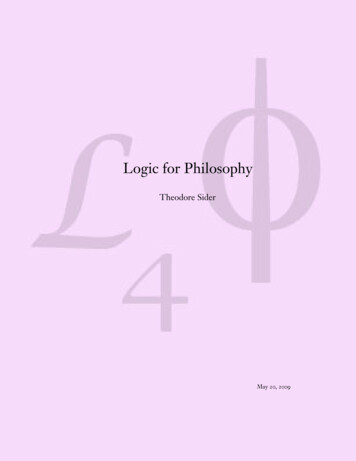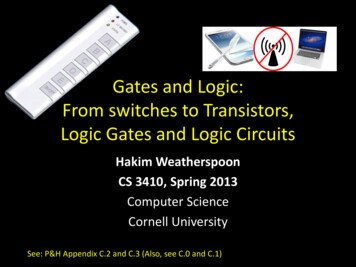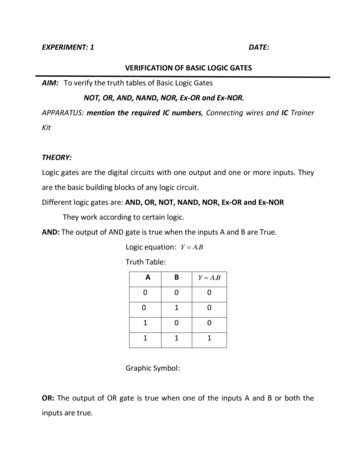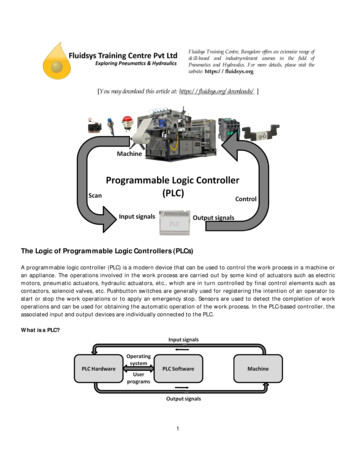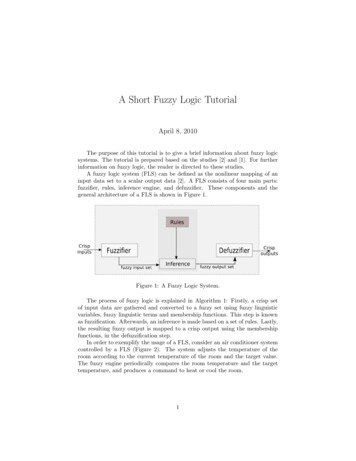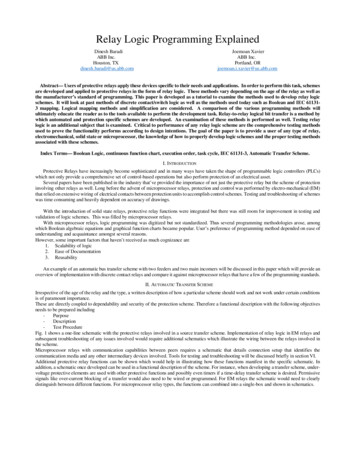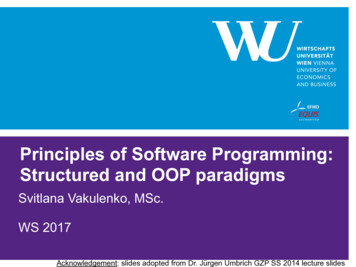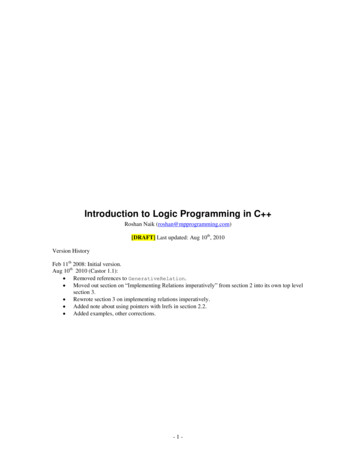
Transcription
Introduction to Logic Programming in C Roshan Naik (roshan@mpprogramming.com)[DRAFT] Last updated: Aug 10th, 2010Version HistoryFeb 11th 2008: Initial version.Aug 10th 2010 (Castor 1.1): Removed references to GenerativeRelation. Moved out section on “Implementing Relations imperatively” from section 2 into its own top levelsection 3. Rewrote section 3 on implementing relations imperatively. Added note about using pointers with lrefs in section 2.2. Added examples, other corrections.-1-
TABLE OF CONTENTS1THE LOGIC PARADIGM . 31.1. Facts . 31.2. Rules . 41.2.1. Recursive rules . 41.3. Queries and Assertions . 41.4. Computation by inferencing . 41.5. Summary . 52LOGIC PROGRAMMING IN C . 52.1 Type relation . 62.2 lref: Logic reference . 62.3 Relation eq: The unification function . 72.4 Evaluating Queries . 72.5 Recursive Rules . 82.6 Dynamic Relations . 92.7 Inline Logic Reference Expressions (ILE) .102.8 Sequences .112.8.1 Generating Sequences .112.8.2 Iterating over sequences .112.8.3 Unification of Collections .132.8.4 Summary.132.9 Cuts – Pruning alternatives .132.10 Relational Ex-Or operator .142.11 Specifying Lref parameters types for relations .152.12 Debugging .153IMPLEMENTING RELATIONS IMPERATIVELY . 16With relation predicate .16With relation eval .17As coroutines .174INLINE LOGIC REFERENCE EXPRESSIONS . 18Creating relations from ILEs .19Limitations of ILEs .20Summary .205LIMITATIONS OF LOGIC PARADIGM . 20Bi-directionality of lref arguments. .20I/O is not reversible. .216LOGIC PROGRAMMING EXAMPLES . 21Factorial 21Directed acyclic graphs. .21Finite Automata (FA) .22Query Expressions .247REFERENCES . 24-2-
Typical questions that arise in Chess (and many other boardgames):- Given a specific layout of pieces on the board, what areall the possible moves for a given piece?- Given a specific board layout, which pieces can be movednext?- Which pieces are under attack in a given board layout?Abstract:This paper is an introductory tutorial for Logic paradigm (LP)in C . No prior experience is required with languages thatnatively support LP. It also demonstrates how LP blends withthe other paradigms supported by C and also the STL. Theability to choose an appropriate paradigm or an appropriate mixof paradigms for solving a given problem is essential and at theheart of multi-paradigm programming. We begin with a briefintroduction to the logic paradigm, followed by a discussion oflogic style programming in C and finally conclude withexamples. The primitives used here for logic programming areprovided by Castor, an open source C library available fromwww.mpprogramming.com. No language extensions to C arerequired to compile the code provided here.1Each question above represents a different but concreteproblem that belongs to the problem domain of Chess.Shifting focus from describing how to solve a particular typeof problem to describing the general rules of the broaderproblem domain allows us to seek answers to a wider varietyof problems within the domain. In the remainder of thissection we will further illustrate facts, rules and queries usinga simple example concerning family relationships. Theprimary focus here is to get a feel for the basic mechanics ofLP.The Logic paradigmLogic programming is a Turing-complete programmingparadigm. The model of computation used in logic is strikinglydifferent from that of the more mainstream imperative andfunctional paradigms. Pure logic programs are entirelydeclarative in nature. When programming in languages based onthe imperative paradigm (like C, C , Java etc.), programmersactively instruct the computer how to solve a specific problemand the computer itself has no knowledge about the problem.Thus, algorithms play a central role. In logic programminglanguages such as Prolog or Gödel, however, it is exactly theopposite. In LP, the programmer provides problem-specificinformation to the computer instead of providing the stepsrequired to solve a specific problem. The computer applies ageneral-purpose problem-solving algorithm to the domainspecific information to produce the desired results. Theprogrammer is not involved with specifying the exact steps (i.e.,the algorithm) used in solving the problem.1.1. FactsFacts are essentially the simplest form of true statementspertaining to a problem domain. They may also be referred toas data. Let us consider a four -person family (Son: Sam,Daughter: Denise, Father: Frank, Mother: Mary, Grandparent:Gary. Here is one way of describing the facts pertaining to thisfamily more accurately:Children facts:1. Sam is a child of Mary2. Denise is a child of Mary3. Sam is a child of Frank4. Denise is a child of Frank5. Frank is a child of GaryGender facts6. Frank is male7. Sam is male8. Mary is female9. Denise is female10. Gary is maleInformation provided to the computer in logic programs can beclassified into facts and rules. This knowledge base of facts andrules describes the problem domain. Specific problems that wewish to solve in this domain are posed as questions or queries.The computer examines the query in the context of the rules andfacts and determines the solution. For example, if the game ofChess (or some other board game) represents our problemdomain, the facts may consist of such things as:- The different kinds of pieces (e.g., white pawns, blackpawns, white king, etc.)- The number of pieces of each kind (e.g., 8 black pawns, 1white king, etc.)- A description of the number of squares and their layout onthe board (e.g., 8x8 board, 32 white squares, 32 blacksquares, etc.)And the rules may consist of:- The rule governing the movement of each kind of piece onthe board (e.g., bishop moves diagonally)- The rule to determine if a piece is under attack- The rule to determine when a game is over and the result ofthe game.The above facts can be used to answer simple questions suchas “Is Sam male?”. This is a basic true/false question and canbe answered by inspecting the gender facts. Since we have anexact match with fact 7, the answer to the question is “yes” or“true”. However, a similar question “Is Frank female?” yields“false” or “no”. This is because we do not have any genderfact stating Frank‟s gender to be female. Thus, whenevermatching evidence is found, the answer is true; and falseotherwise.A slightly different type of question is “What is the gender ofSam?”. This is not a true/false question but it still can beanswered by looking up the gender fact 7. Another questioncould be “Who is the child of Frank?” Again this is not atrue/false question, however, it is a little more interesting asthere is not one but two answers to it, Sam and Denise. This-3-
is the shortest path between nodes A and B?” or “Is graph G aconnected graph?”tells us that we cannot simply stop examining the facts as soonas the first match is found; we need to continue the search till allrelevant facts are exhausted. When there are multiple answers toa question, the person asking the question may be interested inone, some or all the answers.Queries can be classified into two categories. The first kindsimply tests if a certain statement is true: “Is Sam child ofGary?” These are also traditionally referred to as assertions,since the purpose is to essentially check or assert whether afact is true. The second type of query is one that seeks for oneor more solutions. For example, if we ask “Who is the child ofFrank?”, we are not asserting if a fact is true, but insteadasking the system to determine Frank‟s child. We willhenceforth refer to these as generative queries as it requiresthe generation of solutions.A question that cannot be answered based solely on the abovefacts is “Is Mary a parent of Sam?” This is because we have notyet declared what it means to be a parent. There are no directfacts stating any parent-of relationships. To solve this we canadd one fact of the nature “X is parent of Y” for each fact of thenature “Y is child of X” above. This approach is cumbersomeand error-prone especially when the database of facts is large. Abetter approach is to use rules to infer these new facts.1.4. Computation by inferencing1.2. RulesWe have not been very specific, so far, about how answers areactually computed (or inferred). Given the facts and rulesdescribed above it is fairly intuitive for any individual tomentally infer answers to all the questions we have asked. Thefundamental principle behind such inferencing of new factsfrom existing rules and facts is referred to in formal Logic asmodus ponens:Rules are statements used to infer new facts (or data) from anexisting body of facts. Here are some simple rules pertaining tothe family relationships:Parent rule: X is parent of Y if Y is child of X.Father rule: X is father of Y if Gender of X is male andIf A is true andA implies B,then B is true.Y is child of XMother rule: X is mother of Y if Gender of X is female and X is parent of YA and B, above, refer to arbitrary statements. This principle isat the heart of the computational model used in logicprogramming. An intuitive but rather rough approximation ofthe algorithm used to solve queries in logic programmingsystems such as Prolog is as follows:Here X and Y are essentially parameters and not constants like“Sam” and “Frank”. The parent rule provides the ability toanswer questions like “Is Mary a parent of Sam?” or “Who is aparent of Sam?”. Note that the parent and father rules above arespecified only in terms of facts. The mother rule on the otherhand is specified using a combination of facts (gender) and rules(parent) although it could be specified in same manner as thefather rule.1.2.1.1.2.3.Recursive rulesRules can also be specified in terms of themselves. Considerdescribing the ancestor relationship as a rule.Ancestor rule: X is ancestor of Y if X is parent of Y or Z is parent of Y and X is ancestor of ZBuild a list of relevant facts and rulesPick a relevant fact and see if it answers the question.Repeat this until all relevant facts are exhausted.Pick a relevant rule that can be applied to derive newfacts (using modus ponens). Repeat this until allrelevant rules and facts are exhausted.At any step of the inferencing algorithm, there may be morethan one rule and/or fact that can be selected in order tocontinue execution. Each choice leads to a different inferencepath and not all paths necessarily lead to solutions. Paths thatdo not lead to solutions are abandoned and inferencingresumes from the most recent point where other facts and/orrules were available for inferencing. Abandoning the currentpath and resuming execution from an earlier point in order tomake a different choice is known as backtracking.Backtracking continues till all paths of inference have beentraversed. Thus, computation is reduced to traversing differentpaths of inference determined from the facts and rulesavailable. This is similar to performing depth first search in abinary tree where leaf nodes represent candidate results andthe inner nodes represent intermediate results.Now we are in a position to ask “Is Gary an ancestor of Sam?”which should yield true. Similarly if we ask “Who is an ancestorof Sam?”, it should yield Frank, Mary and Gary.1.3. Queries and AssertionsOnce we have built the knowledge-base consisting of facts andrules we are ready to ask questions. Specific problems that needto be solved are posed as queries. We have seen examples ofqueries above for the family relationships. Other examples ofqueries, for instance, when dealing with graphs is to ask “What-4-
;In pure formal logic, the exact order in which facts and rules areselected for application is non-deterministic. This also impliesthat the order in which answers are obtained is not deterministic.Since some paths may lead to solutions quicker than others, inpractice the order of execution is fixed (same as declarationorder) to allow control over efficiency. Fixing the order ofapplication of rules also simplifies reasoning about the executionof logic programs, which is important for debugging.}// f is the father of crelation father(lref string f,lref string c){//. if f is male and c is child of freturn gender(f,”male”)&& child(c,f);//rule2}Facts and rules are both declared as functions with the returntype relation. The parameter types are specified in terms oftemplate lref which stands for logic reference. Here itprovides a facility similar to the pass by reference mechanismin C . However, unlike references in C , logic referencescan be left uninitialized. The value underlying a logicreference can be obtained by dereferencing it with operator *.1.5. SummaryIn this section we described facts, rules, queries, assertions andinferencing. Facts are simply true statements. Rules can be usedto derive new facts. Rules can be specified in terms of facts,other rules or even themselves (i.e. recursive rules). A collectionof rules and facts can be used to answer relevant questions.Questions can be broadly classified into those that simplyrequire a true/false answer or those for which solutions need tobe generated. The former types of questions are referred to asassertions and the latter referred to as generative queries.Assertions have only one answer (i.e. true/false). Generativequeries may have zero or more solutions. “Is Sam male?” is anexample of an assertion. “Who is the child of Mary?” is anexample of a generative query. Logical inferencing is used toanswer questions. It involves examining the facts and applicationof rules. New facts emerge from application of rules whichbecome candidates for future consideration during inferencing.2Function eq is called the unification relation. Its job is toattempt to make its two arguments equal. If any one of itsarguments is an uninitialized logic reference, it will assign theother argument to it. If both arguments have well definedvalues then it simply compares the two arguments. This task isreferred to as unification. Consider the call eq(c,"Sam") inrelation child. If c has been previously initialized with avalue, eq will compare the contents of c with "Sam".However if c has not been initialized, "Sam" will be assignedto c. The type relation, logic references and relation eqwill be discussed further in sections 2.1, 2.2 and 2.3respectively.Logic Programming in C Now let us translate the above facts and rules into C so thatthey can be executed. The examples here make use of Castor, anopen source library that enables logic programming in C .Castor enables embedding of logic style code naturally into C by allowing rules and facts to be declared as classes, functions oreven just expressions. This low level of integration is very usefuland allows for a programming platform where the paradigmboundaries are seamless.Neither eq nor any of the user-defined relations like child orgender return the results of their intended computationimmediately when invoked. Instead they return functionobjects that encapsulate the intended computation. Thefunction objects can be stored in an object of type relation.Their evaluation can be triggered by application of thefunction call operator on relations. Given the above C definitions for the relations, we are in a position to make somequeries and assertions. The following is a simple assertion tocheck if Sam is male:The following C functions represent the child and genderfacts and the father rule (described previously) using Castor:// c is child of prelation child(lref string c, lref string {return eq(c,”Sam”) && eq(p,”Mary”) //fact eq(c,”Denise”) && eq(p,”Mary”) //fact eq(c,”Sam”)&& eq(p,”Frank”)//fact eq(c,”Denise”) && eq(p,”Frank”)//fact eq(c,”Frank”) && eq(p,”Gary”) //fact;}relation samIsMale gender("Sam", "male");if( samIsMale() )cout "Sam is male";p)else12345cout "Sam is not male";Similarly we can check if Frank is Sam‟s father:relation samsDadFrank father("Frank","Sam");if(samsDadFrank())cout "Frank is Sam's father";elsecout "Frank is not Sam's father";// p’s gender is grelation gender(lref string p, lref string g){return eq(p,”Frank”)&& eq(g,”male”) //fact 6 eq(p,”Sam”)&& eq(g,”male”) //fact 7 eq(p,”Mary”) && eq(g,”female”)//fact 8 eq(p,”Denise”)&& eq(g,”female”)//fact 9We can also issue generative queries such as “What is Sam‟sgender?”:lref string g; // g not initialized-5-
relation samsGender gender(“Sam”, g);if( samsGender() )cout "Sam’s gender is " *g;elsecout "Sam’s gender is not known";to terminate. Also, when all solutions have been exhausted,logic reference c will be automatically reset to its originaluninitialized state.Notice how the ability to use fundamental imperativeconstructs like the if statement and the while loop makes thetransition between the logic programming model (in whichresults are generated) and the imperative model (in which theresults are consumed) simple and seamless.Here we pass “Sam” as the first argument and simply leave thesecond argument undefined (i.e., not initialized to any value).Note how the same function gender is used to assert if Sam ismale and also find out Sam‟s gender. When all the argumentshave been defined (i.e., initialized to some value) it performs acheck to see if they satisfy the gender relation. Arguments thathave been left undefined will act as output parameters and willbe initialized with a value that satisfies the gender relation. Thisbidirectional nature of the lref parameters behaving as input oroutput is central to the logic programming model. It is importantto note, however, that lref parameters on relations typically donot act as both input and output simultaneously as is often thecase when using the pass-by-reference scheme in functions likeswap.Function eq, template type lref and type relation alongwith overloads for operators && and provide the foundationfor logic programming in Castor. They are described briefly inthe following sections. For an in depth coverage of theirdesign and implementation, refer to [CastorDesign].2.1Type relationIn logic programming it is common to refer to facts and rulesas predicates or relations. The term “relation” originates inset theory where it is used to imply an association betweensets. So, gender is a binary relation between a set ofindividuals and the set of genders. Generally a strictdistinction between rules and facts is not required whenprogramming with Castor as they can be mixed freely withinthe same function/expression1. Keeping with logicprogramming lingo, we will henceforth refer to functions thatrepresent facts or rules as relations. So, functions with returntype relation are themselves referred to as relations.What happens if both arguments to gender relation areundefined?lref string p, g; // p and g not initializedrelation anyPersonsGender gender(p, g);if( anyPersonsGender() )cout *p "’s gender is " *g;In this case both p and g will be assigned values by gender.Since the person-gender pair (“Frank”, “male”) is declared firstin the gender relation, p will be assigned “Frank” and g willbe assigned “male”.The type relation internally represents a function orfunction object with no arguments and return type bool. Thuschild, gender and father return a function object that canbe evaluated later in a lazy manner.Generative queries, such as samsGender andanyPersonsGender above, may have zero, one or manysolutions. So far we have only generated the one solution fromthem. Iterating over all solutions, quite naturally, involves theuse of a while loop instead of the if statement we have used sofar. The previous example can be rewritten to print all personsand their genders as follows:2.2lref: Logic referenceTemplate type lref is an abbreviation for logic reference andprovides a facility for passing values in/out of relations in theform of arguments, similar to references in C . Unlike C references, a logic reference does not have to be initialized andprovides the member function defined for checking if it hasbeen initialized. The dereference operator * and the arrowoperator - can be applied to access the value referred to by alogic reference.while( anyPersonsGender() )cout *p "’s gender is " *g "\n";Similarly for listing of all Frank‟s children:Now let us understand the initialization semantics of lref.This is helpful reasoning about operational semantics ofrelational code. When an lref T is initialized (i.e.,constructed) or assigned a value of type T (or a typelref string c;int count 0;relation franksChildren father("Frank", c);while( franksChildren() ) { count;cout *c " is Frank's child\n";}// c is now back to its uninitialized statecout "Frank has " count " children";1This is different from the approach taken in classical logicprogramming systems like Prolog. The general approachtaken by Castor, of how to blend relations syntactically withthe imperative languages, was pioneered by Timothy Budd inhis multiparadigm language Leda. Although Castorshamelessly steals this idea from Leda, the underlyingimplementation techniques diverge significantly.Once all solutions have been exhausted, invokingfranksChildren() returns false and causes the while loop-6-
convertible to T), it internally stores a copy of the value. Wheninitialized with another lref T (i.e., copy constructed), bothlogic references will be bound together. References that arebound together will refer to the same underlying value (if any).Thus any change to the underlying value of one logic referenceis observed by all logic references that are bound together. Abinding between logic references cannot be broken. That is, iflogic references A and B are bound together and C and D arebound together, then C‟s binding with D cannot be broken inorder to form a binding with A and B. C will continue to be apart of the binding for the duration of its lifetime. Logicreferences can only be bound by initialization (i.e., copyconstruction) and not by assignment. A binding can only beformed during construction of the logic reference and will beautomatically broken when the logic reference is destroyed.When the last logic reference that is part of the binding isdestroyed, it will deallocate the underlying value.succeeds it returns true; otherwise it return false. Unificationperformed by eq is defined as follows:- If both arguments are initialized, their values arecompared for equality and the result of comparison isreturned.- If only one argument is initialized, the uninitializedargument will be assigned the value of the initializedone in order to make them equal.- If both arguments are uninitialized, an exception isthrown.So unification will generate a value for the uninitializedargument to make both arguments equal, or it will compare itsarguments if both are initialized. In short, unification is a“generate or compare” operation. It is possible to implementother variations to unification, but is generally not required.The expressions returned by the various calls to eq within, forinstance, the gender relation are stitched together to form abigger compound expression using and && operators. It isimportant to note that the resulting compound expression isreturned without being evaluated. These expressions areevaluated in a lazy manner. In other words, these expressionsare stored in an object of type relation and will be subjectto evaluation in the future when needed. The following sectionexamines the evaluation of these expressions in detail.Starting with Castor 1.1, pointers to objects can also be used toinitialize an lref. When using pointers we must specify whetherthe lref should manage the lifetime of the object referenced bythe pointer. For example://lifetime of "Roshan" will be managedlref string s(new string("Roshan"), true);//lifetime of name will not be managedstring name "Naik";lref string s2(&name, false);2.4Given the above relations, we can formulate the query thattests for “Is Sam male?” and store it in a variable samIsMale asfollows:Assignment with pointers is performed using method set ptr:string str "Castor";s.set ptr(&str, false); // deallocates "Roshan".Will not manage lifetime of strrelation samIsMale gender("Sam", "male");The call gender(“Sam”,“male”)does not perform any realcomputation; it simply returns a function object that can belater executed to determine if Sam is male. Invocation of arelation does not execute/evaluate it. This splitting ofinvocation from execution is a case of lazy evaluation. Inorder to execute this expression we simply apply the functioncall operator on the variable that holds the expression:Although using pointers to assign objects to lrefs is useful(especially when mixing paradigms) and efficient, it can also bedangerous if not used carefully. Great care should be takenwhen specifying the lifetime management policy. For instance, ifthe pointer refers to an object on the stack, the lref should not berequested to manage its lifetime. Similarly, if two independentlrefs are made to refer to the same object using pointerassignment / initialization, both should not be requested tomanage the lifetime of the object. Programmer must ensure thatthe objects being handed over to lrefs using pointers continue toexist as long as the lrefs can attempt to access them. Also,accidentally specifying lifetime management policy to falsewhen true is intended will cause memory leaks.2.3Evaluating Queriesif( samIsMale() )cout "Sam is male";elsecout "Sam is not male";The gender relation was defined previously as follows:// p’s gender is grelation gender(lref string p,lref string g){return eq(p,"Frank") && eq(g,"male") eq(p,"Sam")&& eq(g,"male") eq(p,"Mary")&&
in C . No prior experience is required with languages that natively support LP. It also demonstrates how LP blends with the other paradigms supported by C and also the STL. The ability to choose an appropriate paradigm or an appropriate mix of paradigms for solving a given problem is essential and at

